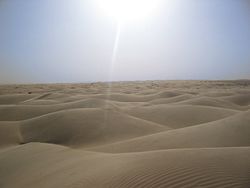Events

- Major climate shift possibly due to shift in solar activity. Glaciers expand, covering plants; atmospheric temperatures fall
- Sahara changes from a habitable region into a barren desert
- Ancient Egypt begins using clay, bone and ivory tags to label boxes, possibly an example of proto-writing
- Indus Valley civilisation (also known as Harappan civilization) begins in Harappa [1]
- c. 3300 BC: Archaeological evidence suggests the transition from Copper to Bronze took place around 3300 BC
- c. 3300 BC: Harappan script is developed in Indus Valley
- c. 3300 BC: Pictographs in Uruk
- 3300 BC: to 3000 BC: Face of a woman, from Uruk (modern Warka, Iraq) is made; it is now in the Iraq Museum, Baghdad (stolen and recovered in 2003)
- c. 3300 BC: The Red Temple, the first phase of the Monte d'Accoddi sanctuary in Northwest Sardinia, is built
- 3300-3000 BC: Evidence of proto-Thracians or proto-Dacians in the prehistoric period; Proto-Dacian or proto-Thracian people developed from a mixture of indigenous peoples and Indo-Europeans from the time of Proto-Indo-European expansion in the Early Bronze Age